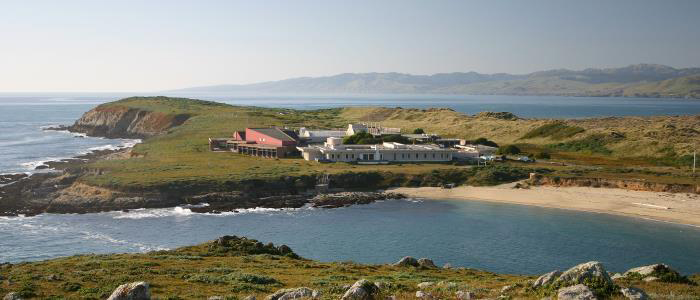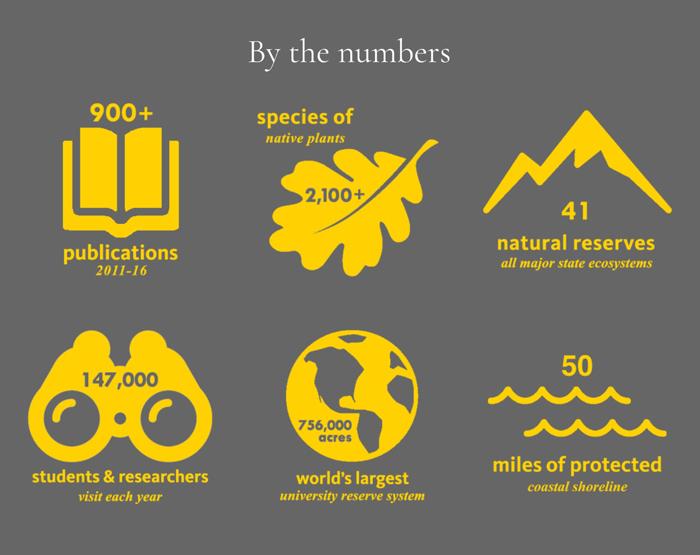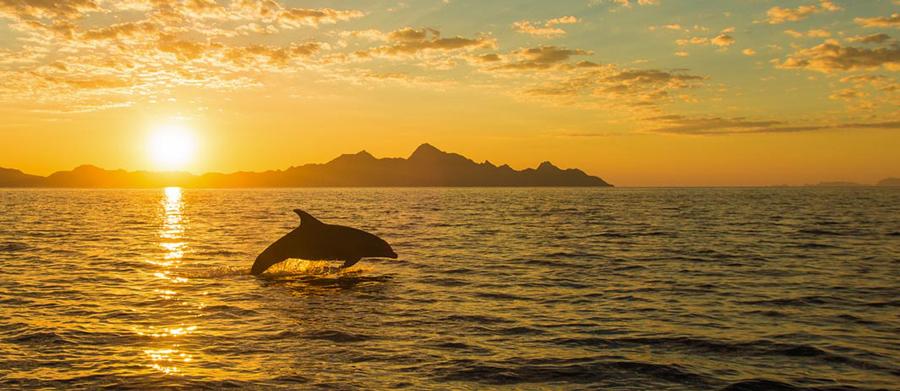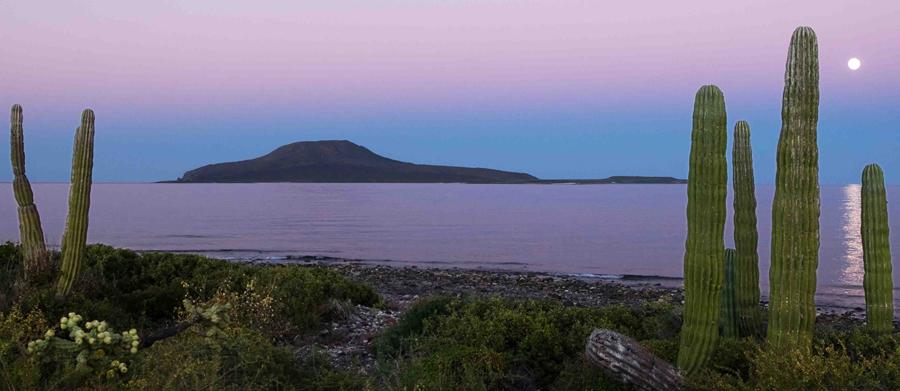
Photo courtesy of UCNRS
Eco-Alianza will visit the Bodega Marine Reserve later this summer.
Eco-Alianza’s founders and supporters couldn’t have been more elated by the “Breaking News” introduced at the top of last month’s Soundings. A five-year Memorandum of Understanding (MoU) with the University of California establishes Loreto as an official “Sister Reserve” and names Eco-Alianza as the Mexican entity empowered to shepherd potentially dozens of scientific research projects that are likely to develop from the Sister Reserve relationship.
This hallmark accomplishment is a game-changer that will positively impact Eco-Alianza and Loreto’s natural, cultural, and educational environment for decades to come. In many ways it’s just the beginning, but the signed MoU in itself is the realization of a years-long effort as the initiative made its way through the University of California administration.
For those unfamiliar with the UCNRS, a little background from its website may be helpful in understanding why this new alliance holds such great potential:
“In the late 1950’s, a group of University of California scientists banded together to start a network of natural areas managed specifically for academic use. They were weary of seeing wildlands that had once served as outdoor laboratories get bulldozed for commercial purposes. They needed samples of natural ecosystems where their equipment would remain undisturbed, and they and their students could study plants, observe animals, and measure ecosystems over the long term.
“In January 1965, the Regents of the University of California established the Natural Land and Water Reserves System, as the Natural Reserve System was first known. Seven University-owned sites became the system’s first Reserves. Today the UCNRS consists of 41 Reserves that include more than 750,000 acres across the state. The Reserves are available not only to students, teachers, and researchers from the University of California, but to qualified users in science, art, the humanities, teaching, and other disciplines. No other university-operated network of field sites in the world can match the size, scope, and ecological diversity of the NRS.”
UC’s Natural Reserve System is quite literally “a library of ecosystems” throughout California. Most of the state’s major habitat types are represented, from coastal tidepools to inland deserts, and lush wetlands to redwood forests. The NRS offers outdoor laboratories to field scientists, classrooms without walls for students, and nature’s inspiration to all.
Several years ago, UCNRS leaders recognized that sites beyond the borders of California may also be useful, in fact critical, to help researchers from the University of California and elsewhere tie their scientific studies into a global context. The first international Sister Reserve arrangement, with Gobabeb Research and Training Centre in Namibia, was established in 2017. A number of exchanges between UC and this African desert reserve are already occurring, including a UC Riverside study-abroad course on ecology and herpetology, and research into desert reptile physiology and how much moisture fog contributes to desert plants.

The MoU signed with Eco-Alianza on June 3 establishes Loreto and the Bay of Loreto National Park as the second international Sister Reserve of the UCNRS. This did not happen by accident. In fact, it is the outcome of hundreds of hours of meetings, dozens of communications back and forth, and several visits to Loreto by professors, researchers, and administrators from the University of California, and managers of its Natural Reserve System, including its executive director, Peggy Fiedler.
In its introduction, the MoU alludes to Eco-Alianza’s strong local relationships – key assets that helped give UCNRS managers confidence to partner with Eco-Alianza. The MoU states “Eco-Alianza de Loreto, AC, is an internationally-recognized Mexican NGO actively fostering cooperative research and agreements through its network of partners, including formal, signed working agreements with the Bay of Loreto National Park (PNBL), the Mexican Secretary of the Environment and Natural Resources (SEMARNAT) through the National Commission of Protected Natural Areas (CONANP), the Universidad Autónoma de Baja California Sur (UABCS), and the Municipality of Loreto.”

From Eco-Alianza’s standpoint, partnering with the UCNRS holds the promise of urgently needed scientific research to provide data critical to conservation management of marine, insular, coastal, and inland environments. The research will help create an international focus on Loreto’s natural wonders and its overwhelming conservation needs, and also will expose Loreto’s youth to terrestrial and marine science and to working scientists. In many cases, faculty researchers from California will partner with Mexican scientists, shining a spotlight on international cooperation (see article below).

Photo courtesy of UC Berkeley Point Reyes Field Station by Allison Kidder
Eco-Alianza will also visit the UC Berkeley Point Reyes Field Station later this summer.
Later this summer, a team of Eco-Alianza staff and board members will visit the UC Davis campus for planning sessions, with visits to the Bodega Marine Reserve (a reserve of the University of California Davis) and Point Reyes Field Station (a partnership between the University of California Berkeley and the National Park Service). Both are part of the UCNRS “library of ecosystems”. Key discussion topics: development of a research field station in Loreto to serve as a home base for researchers, and an examination of the types of research that could most benefit the conservation needs of Loreto.
Please stay tuned as the Sister Reserve initiative begins to take shape.
It is difficult to overestimate the potential far-reaching impacts of the UCNRS Sister Reserve initiative. We took the liberty of asking some local “stakeholders,” to get their thoughts on this development. Here’s what they’re saying:
Co-founder and Executive President
Eco-Alianza de Loreto, AC” icon=”” backgroundcolor=”” iconcolor=”” circlecolor=”” circlebordercolor=”” circlebordersize=”” outercirclebordercolor=”” outercirclebordersize=”” iconrotate=”” iconspin=”no” image=”https://ecoalianzaloreto.org/wp-content/uploads/2019/07/Hugo3.jpg” image_width=”200″ image_height=”227″ link=”” linktext=”” link_target=”_self” animation_type=”” animation_direction=”” animation_speed=””]“We at Eco-Alianza de Loreto, AC, are pleased to represent Loreto, BCS as a partner of the University of California Natural Reserve System. The partnership will strengthen our already excellent working relationship with the Bay of Loreto National Park (PNBL), the University of Baja California Sur (UABCS) and help us to establish a work plan with our Sister Park, the Channel Islands National Park (CINP).
“Effective April 23, 2019, PNBL is operating under a new Park Management Plan, with conservation, fishery replenishment, and ecosystem recovery as central tenets. The marine research component and the conservation experience will create binational educational and research opportunitites as we work to bolster the conservation efforts of the marine park here, a globally significant sanctuary for Blue Whales and so many other migrating and resident species that rely on conservation protection.
“We are grateful to the UCNRS and faculty at UC Davis for taking the lead with this new partnership, and our team looks forward to planning the next steps for the research field station in Loreto. Our goal is to create a strong alliance with our friends on both sides of the border, with the long-term objective of increasing knowledge and building protective networks for wildlife that know no borders.”[/content_box][content_box title=”Dr. Gustavo Cruz
Rector
Autonomous University of Baja California Sur (UABCS)” icon=”” backgroundcolor=”” iconcolor=”” circlecolor=”” circlebordercolor=”” circlebordersize=”” outercirclebordercolor=”” outercirclebordersize=”” iconrotate=”” iconspin=”no” image=”https://ecoalianzaloreto.org/wp-content/uploads/2019/07/gustavo.jpg” image_width=”200″ image_height=”227″ link=”” linktext=”” link_target=”_self” animation_type=”” animation_direction=”” animation_speed=””]“This is a great facilitating effort Eco-Alianza is making, and we are very interested in collaborating with them and with the University of California at Davis and the UC Natural Reserve System. Loreto is a very special small community where we need to work together its social, economic, and environmental challenges. We are glad and fortunate to be here as part of a big family working for that same goal.”[/content_box][content_box title=”Israel Popoca
Director
Parque Nacional Bahía de Loreto (PNBL)” icon=”” backgroundcolor=”” iconcolor=”” circlecolor=”” circlebordercolor=”” circlebordersize=”” outercirclebordercolor=”” outercirclebordersize=”” iconrotate=”” iconspin=”no” image=”https://ecoalianzaloreto.org/wp-content/uploads/2019/07/israel3-200.jpg” image_width=”200″ image_height=”227″ link=”” linktext=”” link_target=”_self” animation_type=”” animation_direction=”” animation_speed=””]“Conserving the biodiversity of Bahía de Loreto National Park requires knowledge gained by accurate information and understanding of ecological and socioeconomic processes. Generating knowledge must be ongoing through environmental and socioeconomic research. Research oriented to planning, decision-making and evaluation of institutional actions ensures the conservation of the biodiversity of Parque Nacional Bahía de Loreto, supported by civil society organizations, academic institutions, and society at large.”[/content_box][content_box title=”Professor Nicholas Pinter
Shlemon Chair in Applied Geosciences
Associate Director, Center for Watershed Sciences
University of California, Davis” icon=”” backgroundcolor=”” iconcolor=”” circlecolor=”” circlebordercolor=”” circlebordersize=”” outercirclebordercolor=”” outercirclebordersize=”” iconrotate=”” iconspin=”no” image=”https://ecoalianzaloreto.org/wp-content/uploads/2019/07/nicholas.jpg” image_width=”200″ image_height=”227″ link=”” linktext=”” link_target=”_self” animation_type=”” animation_direction=”” animation_speed=””]“The vision for a Loreto reserve and field station is to serve as a spark – to bring research, education, scientific recognition and knowledge, and broader visibility to the Loreto region. I am struck with the wealth of natural beauty and scientific potential in the Bahía de Loreto area. This beauty and potential remain largely untapped resources.
“The UC Natural Reserves attract researchers and students from California, from across the U.S. and Mexico, and from around the world. We imagine Loreto as a mecca for scientific visitors to study and admire the area’s abundant natural wonders.
“I myself am a child of the UC Natural Reserve System. The Reserves attracted me as a grad student, drawing me and nurturing me through research projects that now span decades. Some of my fondest memories are sitting around the communal dinner table, after a long day of field work, and talking with scientists from all different disciplines and many different universities. Now I bring my own students to these Reserves that I have studied and come to love, for classes and to start their own research projects.”[/content_box][content_box title=”Linda Kinninger
Treasurer and Co-founder
Eco-Alianza de Loreto, AC” icon=”” backgroundcolor=”” iconcolor=”” circlecolor=”” circlebordercolor=”” circlebordersize=”” outercirclebordercolor=”” outercirclebordersize=”” iconrotate=”” iconspin=”no” image=”https://ecoalianzaloreto.org/wp-content/uploads/2019/07/Linda2.jpg” image_width=”200″ image_height=”227″ link=”” linktext=”” link_target=”_self” animation_type=”” animation_direction=”” animation_speed=””]“The long-awaited establishment of a Sister Reserve agreement between Eco-Alianza and the University of California Natural Reserve System provides a rich opportunity to strengthen our ongoing collaboration between the U.S. and México. This will include the expanded sharing of expertise and technology in areas of conservation, restoration, and sustainable use of resources. Together we can increase capacity building, leverage funding, and develop cross-cultural strategies in support of our “One Ocean” global initiative.”[/content_box][content_box title=”Suzanne Olyarnik
Director
Bodega Marine Reserve” icon=”” backgroundcolor=”” iconcolor=”” circlecolor=”” circlebordercolor=”” circlebordersize=”” outercirclebordercolor=”” outercirclebordersize=”” iconrotate=”” iconspin=”no” image=”https://ecoalianzaloreto.org/wp-content/uploads/2019/07/suzanne.jpg” image_width=”200″ image_height=”227″ link=”” linktext=”” link_target=”_self” animation_type=”” animation_direction=”” animation_speed=””]“The people of Loreto are eager to interact with researchers who can get students excited about science. The Loreto area is rich with biological diversity, as well as intriguing oceanographic and geologic features. From a marine science point of view, it’s an amazing place that we have only begun to explore. I am excited that the NRS can facilitate more people to come down and do academic and applied research to contribute to the management of what they have.”[/content_box][content_box title=”Profesora Arely Arce
Mayor
Municipality of Loreto” icon=”” backgroundcolor=”” iconcolor=”” circlecolor=”” circlebordercolor=”” circlebordersize=”” outercirclebordercolor=”” outercirclebordersize=”” iconrotate=”” iconspin=”no” image=”https://ecoalianzaloreto.org/wp-content/uploads/2019/07/Mayor.jpg” image_width=”200″ image_height=”227″ link=”” linktext=”” link_target=”_self” animation_type=”” animation_direction=”” animation_speed=””]“On behalf of the Municipality of Loreto, we welcome the participation of the University of California, Davis, and the entire University of California Natural Reserve System. Collaborating with local researchers, educators, and authorities, we expect the team will foster additional understanding of our rich natural resources, strengthen the scientific and academic sectors here, and add to the rich cultural mosaic that is Loreto.”[/content_box][content_box title=”Edna Peralta
Executive Program Coordinator
Eco-Alianza de Loreto, AC” icon=”” backgroundcolor=”” iconcolor=”” circlecolor=”” circlebordercolor=”” circlebordersize=”” outercirclebordercolor=”” outercirclebordersize=”” iconrotate=”” iconspin=”no” image=”https://ecoalianzaloreto.org/wp-content/uploads/2019/07/edna-250.jpg” image_width=”200″ image_height=”227″ link=”” linktext=”” link_target=”_self” animation_type=”” animation_direction=”” animation_speed=””]“The Sister Reserve Project will greatly expand research and educational opportunities in our local school system.With access to and participation in ongoing scientific research, our students will have a hands-on opportunity to further their explorations, make their own discoveries, and increase their knowledge base about the bounty of Baja and the Sea of Cortez. We also hope to create a cultural exchange with students from the United States.”[/content_box][/content_boxes][separator style_type=”single” top_margin=”” bottom_margin=”35px” sep_color=”#00ccff” border_size=”” icon=”” icon_circle=”” icon_circle_color=”” width=”” alignment=”center” class=”” id=””][/one_full][one_full last=”yes” spacing=”yes” center_content=”no” hide_on_mobile=”no” background_color=”” background_image=”” background_repeat=”no-repeat” background_position=”left top” hover_type=”none” link=”” border_position=”all” border_size=”0px” border_color=”” border_style=”” padding=”” margin_top=”” margin_bottom=”” animation_type=”” animation_direction=”” animation_speed=”0.1″ animation_offset=”” class=”” id=””][menu_anchor name=”project”][title size=”5″ content_align=”center” style_type=”none” sep_color=”” margin_top=”” margin_bottom=”” class=”” id=””]Funding Approved for First Research Project Under the Sister Reserve Initiative[/title]

Photos courtesy of Richard Jackson
New research will study uplifted marine terraces in PNBL. Carmen Island.
Less than a month after the MoU was signed establishing Loreto as a UCNRS Sister Reserve, 18 months of seed funding was approved by UC-MEXUS for a geological research project within the Bay of Loreto National Park. UC-MEXUS is a bilateral program that funds and encourages collaboration between UC researchers and Mexican university partners.
Professor Nicholas Pinter, one of the project’s principals, explains that “ours is a partnership between UC Davis, UNAM (Hermosillo), UABC (Ensenada), and Williams College (Massachusetts). In particular, one UCD graduate student and one UNAM student will be working in the Bay of Loreto region for an extended period of time.” He explained that the collaborative grant proposal was submitted by five scientists in mid-February, with expectations that the UCNRS Sister Reserve relationship would be culminated.

Photos courtesy of Richard Jackson
New research will study uplifted marine terraces in PNBL. Coronados Island.
Eco-Alianza now is working to help the scientists secure approval for the required permits for research within PNBL. The seed grant will fund initial research, the data from which will be used to seek funding for a related and more extensive long-term project.
The project’s abstract is below:
“Uplifted marine terraces are an important tool for measuring neotectonic deformation, Quaternary sea levels, and other applications. Terraces have been mapped and studied worldwide, including along the Pacific coast of Baja California. To date, only limited terrace research has been done along the central Gulf coast of Baja, and even less work on the offshore islands of Bahía de Loreto, including Islas Carmen, Coronados, and Monserrat. We propose to map, precisely measure, and date these terraces to document paleo-sea level and quantify late Quaternary deformation and fault slip rates in the Loreto Basin. Based on reconnaissance fieldwork in 2018 and previously published studies, we hypothesize that the three closely spaced terraces on Isla Carmen include OIS 5a, 5c, and 5c, which would show uplift significantly more rapid than inferred on the Baja mainland and unusual preservation of sea-level variations through the last interglacial. We will sample and analyze terrace-capping littoral sediments and fossil assemblages on each level to assess paleo-environmental variations through the last interglacial period and back into the Pleistocene. We further hypothesize that Quaternary uplift and deformation in Bahía de Loreto documents the transfer of faulting and tectonic deformation from the Baja mainland into the coastal margin and Gulf of California. This collaboration between UCD and UNAM and UABC is designed to catalyze further research and funded activity, including focused on a new UC Natural Reserve partner arrangement and potential field station in Loreto now being negotiated.”

Eco-Alianza staff photo
Our 2019 gala will come complete with a beautiful new venue, the spectacular 5th Floor of Hotel La Mision. Panoramic views of the mountains on one side and the sea on the other will remind all of us exactly what we’re working to protect. Tickets will be available in the Fall, but for information on sponsorships or to discuss donating an item or experience for the benefit auction, please contact Mark_Hufford@yahoo.com .





